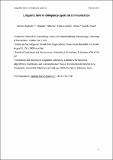Files in this item
Linguistic laws in chimpanzee gestural communication
Item metadata
| dc.contributor.author | Heesen, Raphaela | |
| dc.contributor.author | Hobaiter, Catherine | |
| dc.contributor.author | Ferrer-i-Cancho, Ramon | |
| dc.contributor.author | Semple, Stuart | |
| dc.date.accessioned | 2019-03-26T16:30:06Z | |
| dc.date.available | 2019-03-26T16:30:06Z | |
| dc.date.issued | 2019-02-13 | |
| dc.identifier | 258270349 | |
| dc.identifier | ec5f4c1d-1a19-401c-a7af-808e9daf9196 | |
| dc.identifier | 85062683387 | |
| dc.identifier | 000465431000025 | |
| dc.identifier.citation | Heesen , R , Hobaiter , C , Ferrer-i-Cancho , R & Semple , S 2019 , ' Linguistic laws in chimpanzee gestural communication ' , Proceedings of the Royal Society B: Biological Sciences , vol. 286 , no. 1896 . https://doi.org/10.1098/rspb.2018.2900 | en |
| dc.identifier.issn | 0962-8452 | |
| dc.identifier.other | RIS: urn:F3BA9352AAD3C656655FE5A63232728B | |
| dc.identifier.other | ORCID: /0000-0002-3893-0524/work/55643806 | |
| dc.identifier.uri | https://hdl.handle.net/10023/17377 | |
| dc.description | R.F.C. is funded by grants 2014SGR 890 (MACDA) from AGAUR (Generalitat de Catalunya) and the grant Management and Analysis of Complex Data (TIN2017-89244-R) from MINECO (Ministerio Economía Industria y Competitividad). Fieldwork of C.H. was generously supported by grants from Wenner-Gren Foundation and Russell Trust. S.S. thanks Santander for a Research and Travel grant used to work on this study. R.H. thanks Kölner Gymnasial- und Stiftungsfonds for financial support. | en |
| dc.description.abstract | Studies testing linguistic laws outside language have provided important insights into the organization of biological systems. For example, patterns consistent with Zipf's law of abbreviation (which predicts a negative relationship between word length and frequency of use) have been found in the vocal and non-vocal behaviour of a range of animals, and patterns consistent with Menzerath's law (according to which longer sequences are made up of shorter constituents) have been found in primate vocal sequences, and in genes, proteins and genomes. Both laws have been linked to compression—the information theoretic principle of minimizing code length. Here, we present the first test of these laws in animal gestural communication. We initially did not find the negative relationship between gesture duration and frequency of use predicted by Zipf's law of abbreviation, but this relationship was seen in specific subsets of the repertoire. Furthermore, a pattern opposite to that predicted was seen in one subset of gestures—whole body signals. We found a negative correlation between number and mean duration of gestures in sequences, in line with Menzerath's law. These results provide the first evidence that compression underpins animal gestural communication, and highlight an important commonality between primate gesturing and language. | |
| dc.format.extent | 1523683 | |
| dc.language.iso | eng | |
| dc.relation.ispartof | Proceedings of the Royal Society B: Biological Sciences | en |
| dc.subject | Linguistic laws | en |
| dc.subject | Play | en |
| dc.subject | Gestures | en |
| dc.subject | Information theory | en |
| dc.subject | Compression | en |
| dc.subject | BF Psychology | en |
| dc.subject | DAS | en |
| dc.subject.lcc | BF | en |
| dc.title | Linguistic laws in chimpanzee gestural communication | en |
| dc.type | Journal article | en |
| dc.contributor.sponsor | The Russell Trust | en |
| dc.contributor.institution | University of St Andrews. Centre for Social Learning & Cognitive Evolution | en |
| dc.contributor.institution | University of St Andrews. School of Psychology and Neuroscience | en |
| dc.identifier.doi | https://doi.org/10.1098/rspb.2018.2900 | |
| dc.description.status | Peer reviewed | en |
| dc.identifier.grantnumber | N/A | en |
This item appears in the following Collection(s)
Items in the St Andrews Research Repository are protected by copyright, with all rights reserved, unless otherwise indicated.

